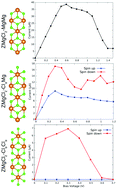Magnetism and perfect spin filtering in pristine MgCl2 nanoribbons modulated by edge modification†
Abstract
The search for new materials, with ideal electronic and magnetic properties for potential applications in nanoelectronics, has been extremely successful so far, and has paved the way for us to reimagine all technological devices. In the present work, we study the design of MgCl2 nanoribbons for applications in nanoelectronics and spintronics, by employing first-principles calculations based on density functional theory (DFT) and non-equilibrium Greens function techniques. Our results show that the properties of MgCl2 nanoribbons depend strongly not only on their geometrical form (armchair or zigzag) but also on the atoms at their edges. The armchair MgCl2 nanoribbon is a semiconductor and the zigzag nanoribbons vary from semiconducting, to metallic, to ferromagnetic, and to half-metallic, depending on the edge terminations. All these nanoribbons are very stable, with a relatively low cohesive energy per atom, and their attributes are not affected by the width of the nanoribbon. From transport calculations, we observed partial spin filtering in the ferromagnetic nanoribbon and perfect spin filtering in the two half-metallic nanoribbons. Moreover, we show how the current versus voltage curves can be fully understood by analysing the alignment of the energy levels of the electrodes. Our results corroborate the promising use of single-layer MgCl2 for the development of spintronics devices.



 Please wait while we load your content...
Please wait while we load your content...